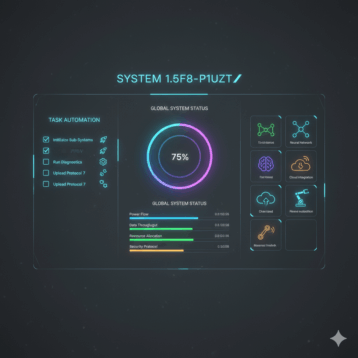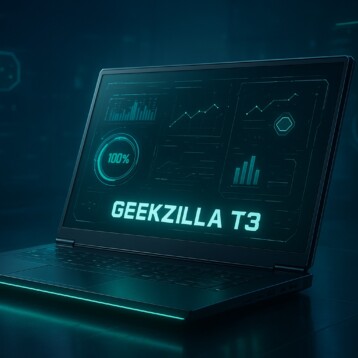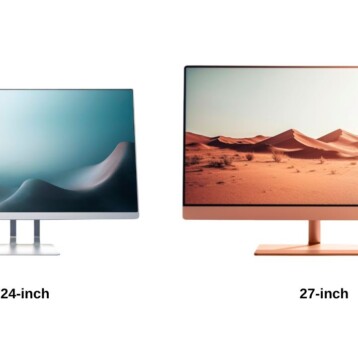Five years ago the Israeli company Explay set out to develop the first nano-sized laser-based projector. When TFOT visited Explay’s Herzliya headquarters in June 2006, we were given the opportunity to see for the first time a few of the prototypes developed by the company. The first was only a projector engine (no battery), about the size of a matchbox. The other prototype, which we later saw in action, was a full projector with a flat battery and was a bit larger then a cigarette box. The final product will be around 20 cc and approximately 5 cm in length.
How a nanoprojector works
|
There are two types of conventional projectors: digital light processing (DLP) projectors and liquid crystal display (LCD) projectors. DLP projectors use a special optical semiconductor called a digital micro-mirror device (DMD). This chip, which was invented in 1987 by Texas Instruments, is a precise light switch that enables light to be modulated digitally via millions of microscopic mirrors. The mirrors are capable of switching on and off thousands of times per second and are used to create a picture comprised of millions of pixels.
LCD projectors use a number of small LCD panels (the same technology used for displays) through which light is passed. As the light passes through the LCD panels, individual pixels can be opened or closed to control the passage of light. This activity modulates the light and produces the image that is projected onto the screen. Both DLP and LCD types use a conventional light source (a special, usually expensive light bulb). To make the projector more powerful, more energy is required, translating to a larger device that produces more heat and thus requires active cooling (which again takes up space, requires energy, and has a tendency to break down). Although some improvements have been made in recent years, these problems put lower limits on the size of projectors based on conventional DLP/LCD technology.
|
It became apparent in recent years that there is a growing market base for a small, light, and relatively inexpensive projector that could be carried along with a laptop, cellphone, or pocket PC to easily present pictures, movie clips, and presentations. Since, as mentioned above, heat and power consumption limitations plague existing DLP/LCD technology, a new technology was needed. Enter Explay, with a radically different way of projecting an image. Instead of using a conventional light source to produce a picture, it set out to develop a laser-based light source for its device. In a conventional projector, only about 15% of the energy is ultimately transferred to the projected image. (Most of the energy is lost as heat, which is why projectors are usually so hot to the touch and require active cooling.) Laser light is much more focused, allowing for a much more efficient way of producing an image. It also requires less energy and thus produces far less heat, eliminating the need for active cooling and so dramatically reducing the size of the projector.
|
The idea of using a laser as a projector light source isn’t new. Several companies around the world, including Microvision, Symbol, and Light Blue Optics, have been working on micro-sized, laser-based projectors for the past several years. In a laser projector, a laser light source is used as the illuminator for a transparent micro-sized display (around a quarter of an inch diagonally) that generates the projected image after it has been magnified by a projection lens.
|
Explay’s technology extends this basic concept by using a combination of laser and LED light sources, which reduces costs and increases the overall efficiency of the system. The microdisplay applied by Explay is known as an Advanced Spatial Light Modulator (ASLM), which is used to increase the light modulation efficiency of the projector from about 25% to as much as 60%. The ASLM can operate quickly enough so that the three basic colors that compose an image (red, green, and blue) are presented in rapid succession, fooling the human eye and creating the illusion of a colored image.
The Explay nanoprojector also uses some high efficiency diffractive and refractive beam-shaping elements, which collect the laser light and direct it to the microdisplay, reducing the power consumption of the projector. Finally, Explay integrated an intelligent application-specific integrated circuit (ASIC), as well as several image processing algorithms, which improve the resulting image.
Explay’s nanoprojector in action
|
At Explay, we were shown the two prototypes currently under development. The first was the nanoprojector engine without a battery. Its size, only somewhat larger than a matchbox, astounded us. The second prototype was larger (about the size of a large cellphone) and included a flat lithium-ion battery, which was still on the outside. Since only the larger device was equipped with a battery, we had a chance to see it in action. Its resolution was QVGA (240×320) but we were assured that there is no problem extending the technology to include considerably higher resolutions (even HDTV, if needed). The connection type used on the prototype was composite-video, chosen for convenience reasons. (In the commercial version other connections might be implemented.) The video source was a Sharp 904 cellphone with composite-video output on which we were shown two video clips (one title by Madonna and a short Japanese animation projected on an A4 sized plastic surface covered with a blank paper. The image was smooth and had relatively low pixelization from a distance of about 1-2 feet (about half a meter). When the screen was moved further away, the picture was enlarged but was accompanied by an evident pixelization effect due to the low resolution of the movie and the prototype projector. One very surprising thing was focus. Everyone who has ever used a projector knows how frustrating it is to always need to refocus the image when changing the distance of the projector. Laser projectors have a unique quality that always keeps the image in focus regardless of the screen distance.
Still pictures that we asked to see displayed some amount of flickering. Explay explained that this might be caused by the specific prototype used and would surely not be a problem in the commercial product.
One of the main difficulties with laser projectors technology is the strength of the light source. A strong laser requires more power and produces more heat, and would be unsafe for the user’s eyes. A weaker laser source, however, might not create a bright enough picture in a lit environment. Explay’s laser projector is currently ongoing tests to receive a Class 1 laser product authorization (Class 1 is a category of lasers that have an output power below the level believed to cause eye damage). Like many conventional projectors, the prototype we saw displayed an image that is not bright enough to watch in a fully lit room; when the light was dimmed, the image improved but was still
|
not bright enough in our view. Explay explained that they have recently improved the projector strength and that their newest nanoprojector displayed in CES 2007 (shown in the pictures), is twice as strong as the prototype we were shown on June 2006.
Since we visited Explay in June 2006, the company improved several aspects of its technology as well as a new design, which appears in some of the pictures accompanying this article. Over the next few months, Explay aims to continue refining its laser projector technology and is currently planning to develop products for a variety of markets and customers.
|
Nanoprojectors can be embedded in a range of different products, including cars and passenger airliners as virtual displays for entertainment systems, inside mobile devices (cellphones, PDAs, MP3 players, laptops, etc.), and as hidden projectors embedded in walls and ceilings for advertising and displaying virtual images. Besides embedded systems, Explay is working on stand-alone products, which would connect to existing video sources either directly or wirelessly and cost initially a few hundred dollars. The company hopes that in a few years it will be able to lower the price to below the 100 dollar mark.
Interview with Explay
To gain more insight into Explay’s technology and future plans, TFOT interviewed Golan Manor, vice president of technical marketing at Explay.
Q: When and how was Explay created?
A: Explay was founded, like companies should be, by first identifying the market need for miniature projectors to give the big picture to small mobile devices. It was established in 2001 on this idea and during its initial stage – the idea and incubation phase – it focused on setting the building blocks of the technology and doing market studies until beginning of 2004 when it raised its seed money and moved into the active development phase.
Q: How does your nanoprojector work?
|
A: Explay’s nanoprojector engine is based on a technology called Laser Projection. In this technology, a laser-based light source is used as the illuminator for a microdisplay (0.24″ diagonal) that acts as a transparent dynamic slide generating the image to be projected. This light is then magnified trough a projection lens and is projected on a screen or wall.
Explay’s technology extends this basic concept and is based on unique architecture incorporating multiple innovations. For the light source, we use a hybrid laser diode and an LED light source in a patented configuration. This delivers an extremely efficient and low cost solution, compared with traditional light sources such as metal halide, xenon lamps, or even all laser or all LED light sources. It also provides an always focused, completely eye-safe image.
For the microdisplay we use an Enhanced 1LCD microdisplay also known as an Advanced Spatial Light Modulator (ASLM) incorporating Micro Lens Array (MLA) technology, which enhances the light modulator efficiency from about 25% to about 60%. It is fast enough to work in a color-sequential manner where light of each color is flashed sequentially while the ASLM changes the image from an Red image to a Green image to a Blue image. This is done fast enough (>180Hz) so that the eye sees a full-color image.
|
To collect the light from the light sources and pass it through the ASLM, we utilize high efficiency diffractive and refractive beam-shaping elements. They efficiently collect and shape the beam from the light source and direct it to the microdisplay, thus dramatically reducing the required power consumption compared to conventional approaches. To control everything, we use a sophisticated Mixed Signal ASIC with unique control, drive, and image-processing algorithms that closely bind the projector elements into an extremely small and efficient package, also providing a glueless interface to 3rd party devices.
These multi-disciplinary innovations result in a first-of-its-kind battery-operated, ultra small, nanoprojector that creates a high quality, powerful, projected display. This state-of-the-art technology provides the missing link for today’s powerful mobile devices.
Q: What part does the LED plays and why did you choose to integrate it into the projector along with the laser source?
A: LED is used for the Blue light source. We chose to use it due to the high cost of Blue lasers. The eye is very insensitive to blue. So we can keep the projector extremely compact and efficient while maintaining the always focused feature.
Q: Do you plan a wireless projector?
A: Wireless projectors are of course possible. We let our partners decide on the required video interface, while we deliver to them a lower level generic interface.
Q: What will be the main applications of the nanoprojector?
2. Cell phone / PDA / laptop projector – for use as an on-the-go, small, light video/photo and presentation aid. Both integrated and stand-alone.
Q: What do you see as your main advantage over the competition (Microvision, Symbol and lightblueoptics)?
A: We believe that our technology is the best suited technology for the embedded nanoprojector application. Whereas as other technologies were developed for other applications and were forced to suit this application, ours was designed with the requirements of nanoprojectors from day one.
Q: What is Explay’s market strategy?
A: Explay is focused on doing what we do best, and that is developing the world’s smallest projector. We are a fabless operation that outsources manufacturing to partners in the Far East. We work with leading consumer electronic brand names in all specifications of mobile devices and sell them our nanoprojector engine to be integrated into their mobile devices or packaged as an accessory.
Q: In most existing projectors, one of the most expensive parts is the light bulb, which needs to be replaced every few hundred (sometimes thousands) of hours. Is there a need to replace something in your product, and how long can the laser projector operate?
A: Our projector utilizes solid-state light sources (laser and LED) that have very long lifetimes – in the thousands of hours, so no replacement will be necessary over the lifetime of the projector.
|
Q: When will the first products based on Explay technology be on the market and at what price range?
A: We expect products to come out in the second half of 2007. This of course very much depends on our consumer electronics partners. On introduction, the product will be in the low several hundred dollar range, and will drop substantially as we ramp up the volume.




















